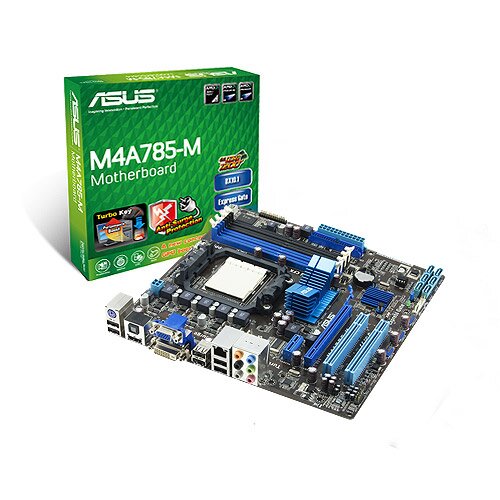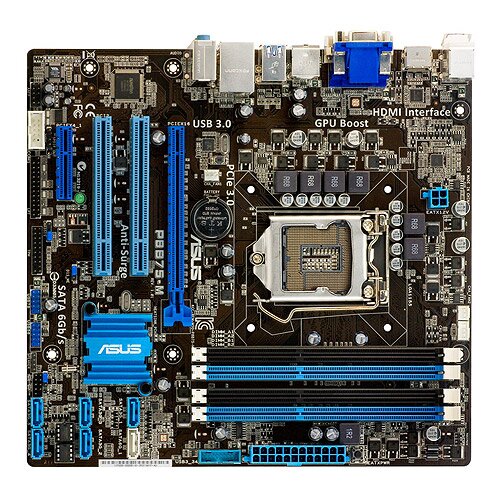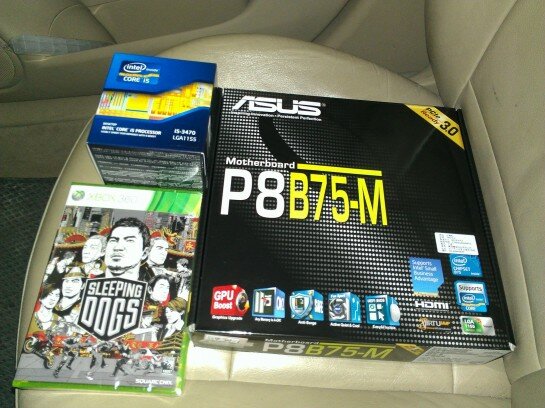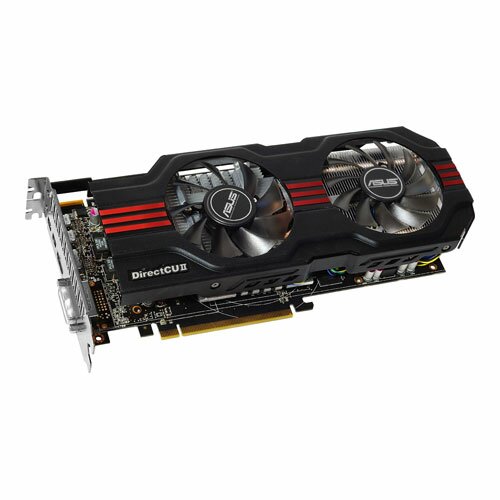I was craving DIY time and looking inside my case I saw that my gradually aging ASUS M4A785-M motherboard needed to go. He has served me well and proven to be a very good board on a budget, especially paired with an AMD Phenom II X4 Black Edition CPU. But times are a-changing and the desire to have PCI Express 3.0, USB 3.0, SATA 6Gb/s, and highlights like UEFI BIOS was too much to resist. Plus, I can’t go more than a few months without wreaking some havoc inside my PC. You should see my cable management. The cables are everywhere. Actually, I have no cable management other than managing not to trip over them.
I decided to control my budget. I wanted Intel Ivy Bridge and all the new features, but I just didn’t want to spend a lot of money so I went with an ASUS P8B75-M. Yes, I’m a firm mATX user, I like the smaller form factor, even though working on one when installing parts is more challenging than with a regular ATX case. For example, my fancy SeaSonic modular power supply took some struggling to fit back in the day, which at one point may have involved my foot.
Anyway, I decided to match the P8B75-M with a 22nm Intel Core i5-3470 which is a decent mid-range CPU. Some overclocking potential, but clearly not top of the line. I’m not a top of the line type of person in most things, and when it comes to overclocking, I can settle for good performance since I don’t personally benchmark too much aside from Fraps or Unigine for personal reference.
For memory I already had 16GB 1333MHz DDR3, and for graphics my existing ASUS HD 7870 DirectCU II TOP finally found itself liberated from the shackles of a PCI Express 2.0 board. I have to say I am sorely tempted now by the HD 7950 DirectCU II TOP, but that three slot monster will simply not fit in my case.
Let’s talk about the P8B75-M. The B75 I regard as the unsung hero of the Intel 7 series. The Z77 and H77 chipsets seem to get all the attention, but the B75 is awesome. The B stands for business, so you actually get a lot of neat features like Intel SBA (Small Business Advantage), Intel Active Management Technology, and Intel Rapid Storage Technology, all designed to make work and productivity better.
Naturally, in my case they’ll be rather wasted. But still, most other current Intel features make an appearance: Smart Response, Smart Connect, and Rapid Start are all here.
ASUS adds a lot to the board. UEFI BIOS is a charm to work with, I mean experiencing it at work is one thing, but when you can literally setup boot priorities with your mouse while drinking a coffee in like two seconds, you know you’re onto something good. The board also ships with LucidLogix Virtu MVP GPU virtualisation, GPU Boost to accelerate onboard graphics, tough anti-surge protection, the EPU energy management engine, and nifty Fan Xpert, which does make a tangible difference when managing your case fans of which I have three. Network iControl is also provided for bandwidth prioritization, but I haven’t looked into that yet. Anyway, the board uses Intel Ethernet and speed tests I’ve done show this does lower latency. Not by a huge amount, but enough.
The fan management results in a really quiet PC and anyway, the i5 is basically silent, even under load. Kudos to Intel for pulling that off!
Installation was as straightforward as can be, the board and CPU went in quickly. I’m personally of the opinion that you don’t really build PCs anymore, you just put the parts together. But it’s still endless fun and so satisfying. Oh, and I did test the MemOK! feature with some ancient memory, and the board did post.
So, if you’re looking for a cost-effective and very future-proof board (it’s Windows 8-ready, technically), the P8B75-M should be a contender. It has most of the highlights that make the Intel 7 series so good, but at a price point even a cheaper can love. And in daily usage/gaming, you’ll get essentially the same performance, though of course you can’t expect the overclocking and high end benchmarking the Z77s provide.
Thanks for listening and let us know what you think!






Suds McSoapdish
Thirty years ago, toddler Suds got his first taste of just how enjoyable technology can be when his parents gave him an Atari 2600. He soon picked up on the wonders of the Commodore 64, and the rest is history in the form of a long list of consoles, 80’s home computers and PCs built and assembled with great fervor. Writing and technology gradually moved up from hobbies to professions as Suds became the man he is today, and although he’s worked and traveled the world and experienced many things, technology, especially computing and gaming, has remained a solid constant.